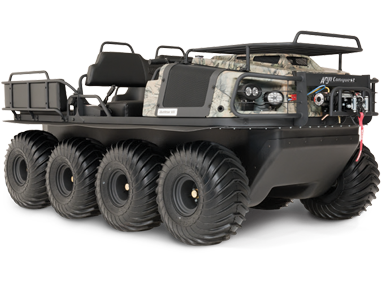How to Steer an Argo XTV

The Principles of Skid Steering
When any vehicle goes around a turn, the inner wheels spin slower than the outer wheels. On cars, ATVs and UTVs, this is done by changing the angle of the front wheels. With a skid steer system, the wheels on one side are slowed down by a steering brake. On an XTV, the handlebars are connected to the steering brake system, so the controls feel more like an ATV even if the function is completely unrelated. This same steering system is used on skid steer loaders, although the XTV’s design gives it different handling characteristics.
The drive system is always sending power to every wheel like a four-wheel drive truck or SUV that has its differentials locked. Like these vehicles, the inner wheels of an XTV will “scrub,” breaking traction in turns. However, since the contact patch of the vehicle is so large, there’s less traction per square inch. This makes it easier for the tires to break loose, making turns smooth and safe, even on pavement.
Making a Turn
To turn, pull one handle toward you and push the other away from you. This will activate the steering brake on the side that corresponds to the handle being pulled, so the vehicle will steer in the direction the bars are pointing. Since there is no direct connection to the wheels, the bars won’t have the same resistance and feel as a motorcycle or ATV. At full lock, the steering brake will slow the inner wheels by about one third. Standard transmissions apply the steering brakes all at once, while Admiral transmissions can apply the brakes gradually.
When turning, make sure the area around the rear outer corner is clear of obstacles. As the XTV turns, the outside of the vehicle will move past the inside, causing the rear end will swing out. This is more pronounced on 8-wheel XTVs.
It’s important to keep the brakes from overheating. Instead of making a gradual turn, take it in small sections, turning hard to change the vehicle direction, then straightening the handlebars and letting the vehicle move forward before turning again.
To reduce stress on the transmission and steering brake, never turn the handlebars more than necessary. If the vehicle isn’t decreasing its turning radius as you move the bar, don’t turn it anymore. Once the turn has been made, straighten the bars. While the vehicle may track straight with the bar tilted, the steering system may be lightly applying one of the brakes, causing it to overheat.
Turning While Backing Up
When you want to turn in a vehicle with a steering rack, you turn the wheel or handlebars in the opposite direction of the turn. In a skid steer vehicle like an XTV, you turn the bars in the same direction going forward or in reverse. Remember that the controls are applying steering brakes, so you’re always slowing down the inner wheels in a turn.
Making a Sharp Turn
Shifting into low gear increases the amount of force the steering brake can exert, causing the inner wheels to stop on standard transmissions. If your model has an Admiral transmission, the braking resistance changes how the differential system works, make it spin the inner wheels in reverse.
The gear mechanism is not synchronized, so shifting on the go will cause grinding and possibly transmission damage. To switch between high and low gear, first, stop the vehicle and hold down the service brake pedal. Once fully stopped, it’s safe to shift the transmission.
Improving Steering Performance
Want to add a fan to keep the steering system cool in difficult conditions? Would adding a set of tracks help you conquer soft surfaces? When you want to modify your XTV or need it serviced, go to Shank’s Argo. We’re one of the largest Argo dealers in the East with parts and accessories you need, and we have decades of experience with outdoor equipment. Visit us at 4900 Molly Pitcher Highway in Chambersburg, PA. That’s one mile East of I-80 from Exit 10 to Marion.
